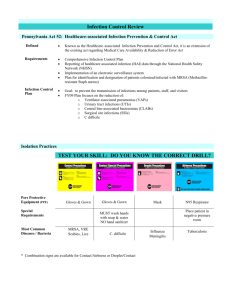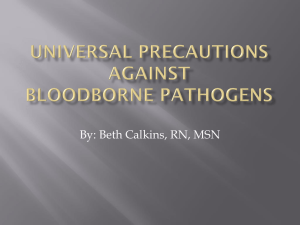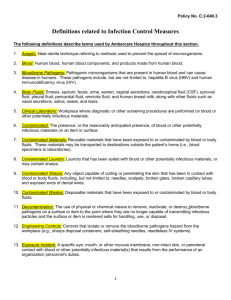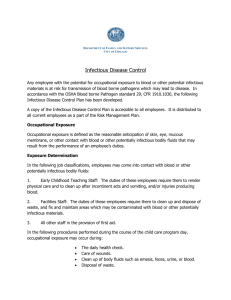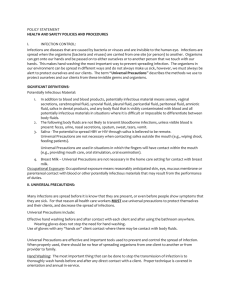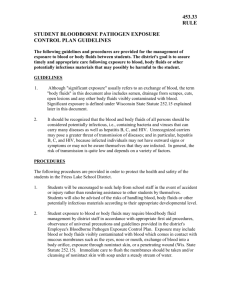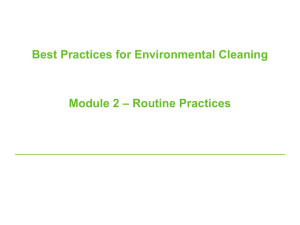Infection Control II
advertisement
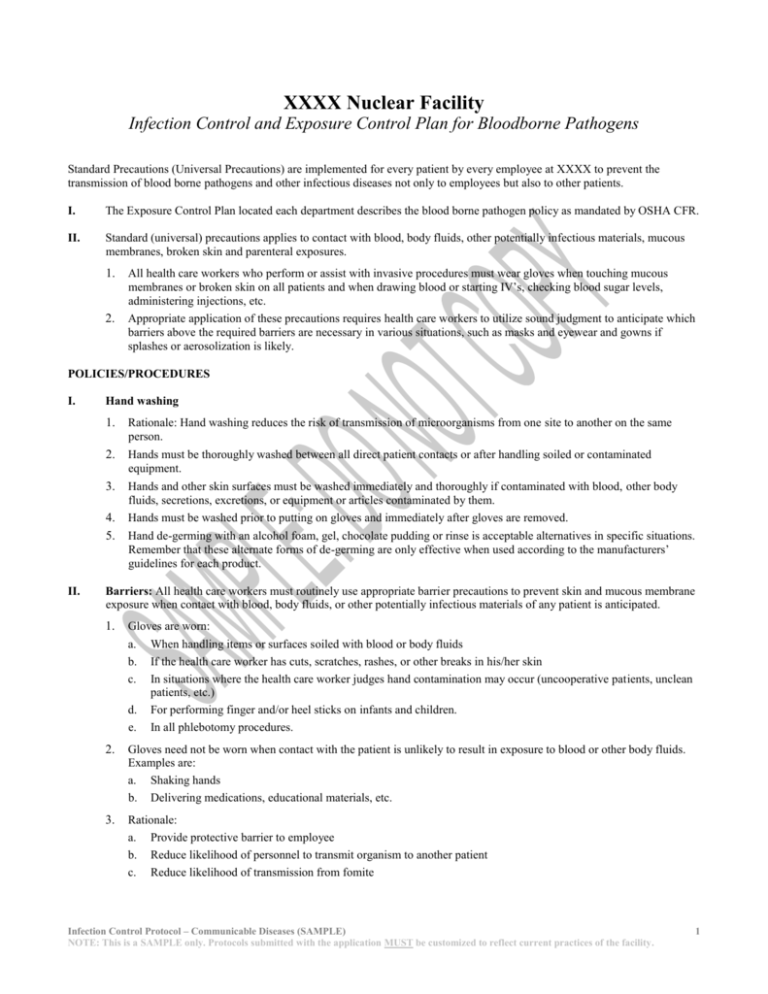
XXXX Nuclear Facility Infection Control and Exposure Control Plan for Bloodborne Pathogens Standard Precautions (Universal Precautions) are implemented for every patient by every employee at XXXX to prevent the transmission of blood borne pathogens and other infectious diseases not only to employees but also to other patients. I. The Exposure Control Plan located each department describes the blood borne pathogen policy as mandated by OSHA CFR. II. Standard (universal) precautions applies to contact with blood, body fluids, other potentially infectious materials, mucous membranes, broken skin and parenteral exposures. 1. All health care workers who perform or assist with invasive procedures must wear gloves when touching mucous membranes or broken skin on all patients and when drawing blood or starting IV’s, checking blood sugar levels, administering injections, etc. 2. Appropriate application of these precautions requires health care workers to utilize sound judgment to anticipate which barriers above the required barriers are necessary in various situations, such as masks and eyewear and gowns if splashes or aerosolization is likely. POLICIES/PROCEDURES I. II. Hand washing 1. Rationale: Hand washing reduces the risk of transmission of microorganisms from one site to another on the same person. 2. Hands must be thoroughly washed between all direct patient contacts or after handling soiled or contaminated equipment. 3. Hands and other skin surfaces must be washed immediately and thoroughly if contaminated with blood, other body fluids, secretions, excretions, or equipment or articles contaminated by them. 4. 5. Hands must be washed prior to putting on gloves and immediately after gloves are removed. Hand de-germing with an alcohol foam, gel, chocolate pudding or rinse is acceptable alternatives in specific situations. Remember that these alternate forms of de-germing are only effective when used according to the manufacturers’ guidelines for each product. Barriers: All health care workers must routinely use appropriate barrier precautions to prevent skin and mucous membrane exposure when contact with blood, body fluids, or other potentially infectious materials of any patient is anticipated. 1. Gloves are worn: a. When handling items or surfaces soiled with blood or body fluids b. If the health care worker has cuts, scratches, rashes, or other breaks in his/her skin c. In situations where the health care worker judges hand contamination may occur (uncooperative patients, unclean patients, etc.) d. For performing finger and/or heel sticks on infants and children. e. In all phlebotomy procedures. 2. Gloves need not be worn when contact with the patient is unlikely to result in exposure to blood or other body fluids. Examples are: a. Shaking hands b. Delivering medications, educational materials, etc. 3. Rationale: a. Provide protective barrier to employee b. Reduce likelihood of personnel to transmit organism to another patient c. Reduce likelihood of transmission from fomite Infection Control Protocol – Communicable Diseases (SAMPLE) NOTE: This is a SAMPLE only. Protocols submitted with the application MUST be customized to reflect current practices of the facility. 1 III. IV. 4. Gloves are disposable single use: a. Disposed in proper receptacle b. Changed after handling infective material before continuing care of that patient to avoid cross-contamination to other body sites of patient. 5. Gowns or aprons must be worn during procedures that are likely to generate splashes of blood, body fluids, or organisms to personnel clothing. 6. Masks and protective eyewear must be worn during procedures that are likely to generate droplets of blood or other body fluids to prevent exposure to mucous membranes of the mouth, nose and eyes. 7. Eyewear may be washed (personnel wear gloves) with soap/warm water and clinic disinfectant between uses unless gross soiling. Eyewear grossly soiled – discard and replace with new pair. CPR 1. To minimize the need for emergency mouth-to-mouth resuscitation, mouth pieces, resuscitation bags, or other ventilation devices are strategically located and available for use in areas where the need for resuscitation is predictable. 2. AED’s (Automatic Defibrillator Devices) are located strategically throughout the facility. a. Employees should familiarize themselves with where these devices are kept in their respective work areas (e.g., clinics, research facilities, etc.) b. All employees are required to have current CPR certification. The American Heart Association certifies for a twoyear period and this is the program used by XXX for certifying and re-certifying employees. These classes are offered at different times throughout the year XXX employees. Sharp items (needles, scalpel blades, lancets, scissors, tweezers, and other sharp instruments) are considered potentially infective and must be handled with extraordinary care to prevent accidental injuries (IL code, OSHA, CDC). 1. Needles should not be recapped, purposefully bent or broken by hand, removed by hand, removed from disposable syringes, or otherwise manipulated by hand. After use, disposable syringes and needles, scalpel blades, lancets and other sharp items must be placed in puncture-resistant containers located as close as practical to the use areas. 2. Certain procedures may require recapping of needles (such as blood gas draws). If needles must be re-capped, a special single handled scoop method must be used (e.g., “cap holding” device or single handed “scoop” method). 3. Large-bore reusable needles or other sharps must be placed in a puncture resistant container for transport to the reprocessing area. 4. Sharp instruments or devices must be cleaned carefully to prevent injury. Visible soiling should be cleaned before the items are sterilized. The employee responsible for cleaning and sterilizing of the instruments should wear gloves when cleaning the visible soiling as well as when the items have soaked in the disinfectant/sanitizer and are being prepared for sterilization. V. Hepatitis B Vaccine: Employees who are at risk of exposure to blood and body fluids and other potentially infectious materials must be offered Hepatitis B vaccine. VI. Personnel Health VII. 1. 2. Routine work restrictions for personnel who are pregnant or who have chronic illness are not necessary. 3. All health care workers with evidence of any illness that may compromise their ability to adequately and safely perform invasive procedures should be evaluated medically to determine whether they are physically and mentally competent to perform invasive procedures. No health care worker who has exudative lesions or weeping dermatitis should perform or assist in invasive procedures or other direct patient-care activities or handle equipment used for patient care until the condition resolves completely. Blood/Body Fluid Spills 1. Chemical germicides that are approved for use as “clinic disinfectants” and are tuberculocidal when used at recommended dilutions can be used to decontaminate spills of blood and body fluids, and other potentially infectious materials. 2. Gloves must always be worn for cleaning spills of blood and body fluids and other potentially infectious materials (disposable cleaning cloth, gloves, etc. are placed in red plastic biohazard bags for appropriate disposal). For large spills, gowns and eyewear may be necessary. Infection Control Protocol – Communicable Diseases (SAMPLE) NOTE: This is a SAMPLE only. Protocols submitted with the application MUST be customized to reflect current practices of the facility. 2 3. VIII. IX. Environmental cleaning must be done routinely: 1. Horizontal surfaces (hard surfaced flooring, exam tables, countertops, sinks, etc.) and all non-invasive equipment used by the patient (blood pressure cuffs, monitors, and other such equipment) must be cleaned on a regular basis and when visibly soiled. 2. Blood or body fluid spills must be cleaned immediately. Soiled linen: 1. 2. 3. 4. X. Clinic disinfectants a. 5.25% bleach made fresh daily b. SaniMaster Q (Trade name) c. Dispatch (Trade name) d. SaniMaster Phenolic (Trade name), surgical suites only Soiled linen should be handled as little as possible and with minimum agitation All soiled linen should be bagged at the location where it is used Linen must be sorted or rinsed in patient care areas Linen soiled with blood or body fluids must be placed and transported in bags that are leak resistant (gray, white, yellow shiny bags) Infectious Wastes: 1. Defined: a. Used and unused sharps, including items made of glass or other breakable materials, which are contaminated with infectious waste b. Biologicals, cultures and stocks from medical and pathological facilities and waste items contaminated by these materials c. All blood and blood products, and specific body fluids and other body fluids containing visible blood. This means liquid or semi-liquid blood and other potentially infectious materials; contaminated items that would release blood or other potentially infectious materials in a liquid or semi-liquid state if compressed; items that are caked with dried blood or other potentially infectious materials and are capable of releasing these materials during handling. The specific body fluids are peritoneal fluid, amniotic fluid, pleural fluid, synovial fluid, pericardial fluid, vaginal secretions, and semen (CDC, OSHA, EPA). d. Pathological waste; including tissues, body fluids, and body parts removed during surgical procedures. 2. Procedures: a. Infectious wastes are secured in red plastic bags and are placed in designated trash receptacles in all clinics and research facilities for housekeeping to remove b. Bags are transported to the incinerator area or pick up area by housekeeping staff c. Infectious waste must not be discarded in unmarked receptacles or down undesignated drains. XI. Noninfectious waste: Noninfectious waste is to be placed in leak proof impervious (clear plastic) bags for pickup and disposal by Housekeeping staff. XII. Fluid wastes: Fluid wastes are to be carefully poured down designated drains connected to the sanitary sewer: wear protective equipment as needed. Written: Revised: Reviewed: Date: Date: Date: Date: Infection Control Protocol – Communicable Diseases (SAMPLE) NOTE: This is a SAMPLE only. Protocols submitted with the application MUST be customized to reflect current practices of the facility. 3
